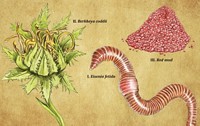Advertisement
Grab your lab coat. Let's get started
Welcome!
Welcome!
Create an account below to get 6 C&EN articles per month, receive newsletters and more - all free.
It seems this is your first time logging in online. Please enter the following information to continue.
As an ACS member you automatically get access to this site. All we need is few more details to create your reading experience.
Not you? Sign in with a different account.
Not you? Sign in with a different account.
ERROR 1
ERROR 1
ERROR 2
ERROR 2
ERROR 2
ERROR 2
ERROR 2
Password and Confirm password must match.
If you have an ACS member number, please enter it here so we can link this account to your membership. (optional)
ERROR 2
ACS values your privacy. By submitting your information, you are gaining access to C&EN and subscribing to our weekly newsletter. We use the information you provide to make your reading experience better, and we will never sell your data to third party members.
Recycling
Food-based aerogel recovers gold from e-waste
The protein sponge sucks up three times as much gold per gram as a typical activated carbon adsorbent
by Carolyn Wilke, special to C&EN
February 6, 2024

Adsorption—not alchemy—can transform waste into recycled gold. A protein sponge made from food waste recovers gold from e-waste, creating high-purity nuggets (Adv. Mater. 2024, DOI: 10.1002/adma.202310642).
“This study is an excellent example of developing sustainable and environment friendly materials technologies,” writes Mustafa O. Guler, a biomaterials scientist at the University of Chicago who wasn’t part of the work, in an email. “By exploring innovative food waste materials for sustainability solutions, the researchers have successfully developed a new method for recycling valuable metals.”
Raffaele Mezzenga, a materials scientist and physicist at the Swiss Federal Institute of Technology (ETH), Zurich, and colleagues started with whey protein, a byproduct of the cheesemaking industry, and made a low-density aerogel. Making the spongelike material is cheap, he says. “The value of the gold we recover is 50 times the value we invest to transform the protein into this sponge.”

The researchers placed whey protein into an acidic solution and heated it, which unraveled the proteins from tiny balls into strands. Then they freeze-dried the solution, forming a lightweight puck with high porosity. “You can place them on the top of a flower. And the advantage of having aerogels is that they have high surface area,” says Mohammad Peydayesh, a chemical engineer who’s also part of the research team at ETH Zurich.
The researchers tested the gel’s ability to adsorb gold from a solution also containing other metals—including copper, lead, and nickel—at the same concentration. The aerogel sucked up 93% of the gold while removing less than 10% of any of the other metals. To test the protein sponge with real e-waste, the team dissolved computer motherboards in aqua regia, a mix of nitric acid and hydrochloric acid. Gold ions from the mixture settled on the surface of the aerogel and were reduced, forming metallic gold. Each gram of aerogel snatched 190 mg of gold. Burning the aerogel freed the gold, turning it into a tiny hunk of metal.
“It was really exciting to find this nugget in the ashes,” Peydayesh recalls. The nugget was about 91% gold, which corresponds to about 21 to 22 karats.
Because of its exceptional porosity, surface area, and high density of chemical functional groups, the aerogel exhibits a “remarkable ability” to quickly adsorb gold ions with a high capacity and selectivity, writes Peng Yang, a polymer chemist and materials scientist at Shaanxi Normal University who wasn’t part of the study, by email. Further study may reveal improvements in the method used to make the gel or identify ways to recover the gold without destroying the sponge to make the process more cost-effective, Yang says.
The method already presents an improvement over activated carbon, a more typical adsorption method used to recover gold. Each gram of activated carbon only adsorbed about 60 mg of gold from an e-waste mixture, the team found. Because it takes a lot of energy to create activated carbon, recovering the same amount of gold using activated carbon had a higher environmental impact in a life cycle analysis.
The team is already eyeing other food waste proteins, such as keratin and those from the production of tofu, that could potentially help with other needs, such as the recycling of rare earth metals. “We can simultaneously address the global waste of food and e-waste to produce something really precious,” Peydayesh says.





Join the conversation
Contact the reporter
Submit a Letter to the Editor for publication
Engage with us on Twitter